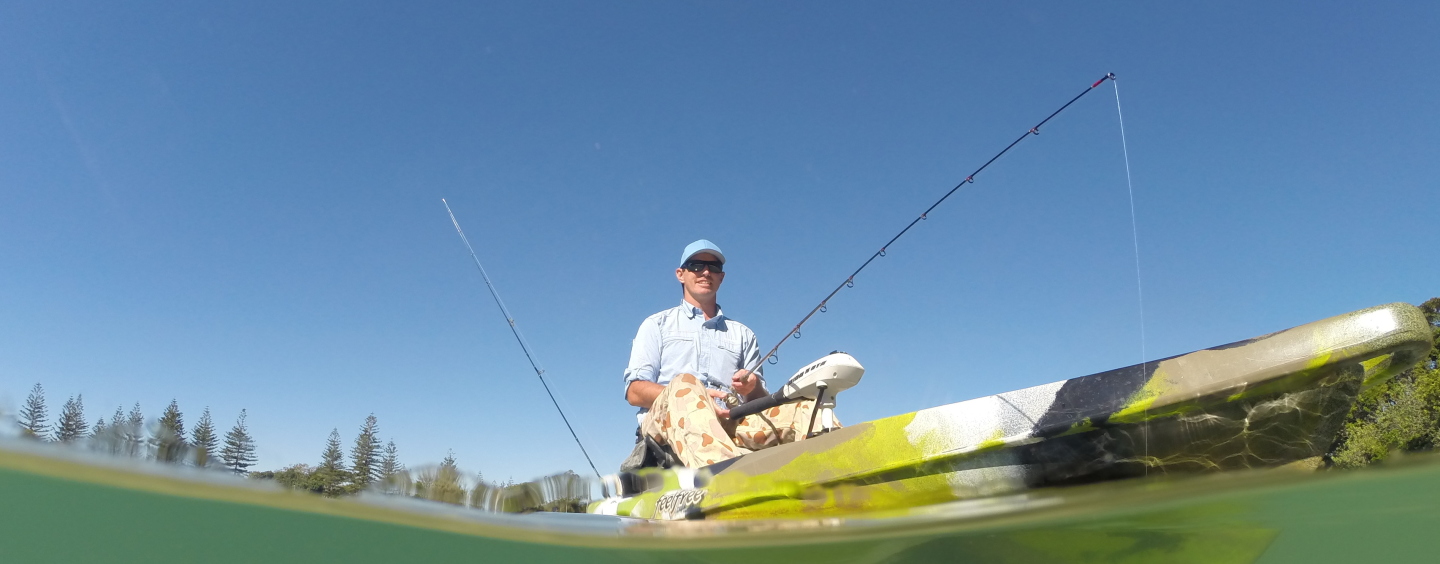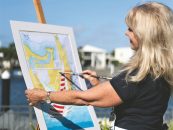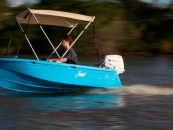If you are in search of an adventure, escapism, and a sports fishing challenge with opportunities to fish waters inaccessible to boats, then kayak fishing is for you. The Gold Coast is blessed with such an incredible variety for kayak fisher locations with excellent access to launch across the region.
There is a basic difference between kayak fishing and fishing from a boat. With a kayak, you fish slower and more thoroughly because you are limited in the distance you can cover. You can also sneak up on fish and often watch them attack a lure right beside you because your profile in the water is much smaller.
When kayak fishing during the months from September to December, flathead and bream are the easier targets nearing the summer season. If you are looking to take your kayak fishing challenge up a notch, have a go at bass, trevally or mangrove jack. I recommend bass in a freshwater creek or out at Hinze Dam, trevally in Nerang or Coomera Rivers, and mangrove jack in a heavily structured stretch of Currumbin or Tallebudgera Creek.
Where to go
Getting a feel for kayak fishing is best done by fishing shallow waters and flats were you can pick up bream and flathead pretty consistently, and in calm safe conditions. As you learn about your kayak and grow in confidence, you can take the adventure of kayak fishing further.
The most significant elements to be worried about if you are considering kayak fishing offshore, estuary or fresh water for the first time are wind, wave and tide action. Keeping close to a shoreline is best as you learn while ensuring your safety, and it is usually your best chance for finding fish. That is why estuaries, canals and fresh water streams are my favourites.
The lower reaches of rivers and creeks are great to try out kayak fishing. Tallebudgera and Currumbin Creeks are my pick spots as they are generally wind protected and shallow, and have clear waters with plenty of access and low tidal flow.
If you are social media savvy, direct message some of the leading kayak fishermen targeting the same waters you want to fish.
Kayaking for jacks
In South East Queensland, the mangrove jack present the toughest challenge in our calm water creeks, estuaries and rivers. The bone-rattling fight and cunning feeding tactics make them the ultimate sports fishing target. They belt lures like nothing else, and can pull you around at their mercy once hooked – a feeling you will never tire of.
The Gold Coast canals are home to our country’s biggest estuary mangrove jack, with the Nerang and Coomera Rivers and nearby canals providing endless options for anglers looking to find some calm water. Also, the backwaters of Tweed River and Tallebudgera are perfect spots for kayakers to test their nerves against jacks.
The best strategy is to get out on the water in low light conditions, early morn or late afternoon to escape the boat traffic. Drifting live baits into fallen trees in the water or around bridge pylons is a deadly technique. However, most kayakers learn to prefer the heart-in-mouth experience of tossing lures into a jack’s lair and trying to get it back to the kayak. A technique is to challenge yourself to cast as close as possible to the immense variety of structures you find and slowly retrieve your lure so you can feel the beating cadence as it works its way into the strike zone. You want to land the lure close enough to the cover as possible. You want to scare the paint off it, swimming it aggressively with long pauses right in front of the fish holding beside bridge pylons, moored boats and pontoons. Allow the feeding fish time to hone in on your presentation by stalling your retrieve every now and then. Repeat this cast-and-retrieve technique as you drift your favourite stretch of water and hang on tight. Exercise your discretion and etiquette in these built-up residential areas.
Which kayak to buy?
There are different kayaks suited for various locations depending on the accessibility to the water’s edge and storage requirements. My main considerations when deciding to buy a kayak for fishing are comfort, stability, and stand’n’cast option. I also want the ability to add an electric motor, and to be able to be carried and loaded onto a car by one person. I make sure the kayak is specifically designed as a fishing platform, and has raised seat for comfort and back support to allow longer fishing sessions with a better position to fight bigger fish.
A comfortable and stable casting position is key when choosing your kayak. There are two important points to consider that are the biggest factors when you are trying to get the upper hand to land a big fish. First, you should expect long sessions on the water. And second, you should be able to give everything you can in a fight with a fish.
Aside from a kayak, you will require a paddle, a rope, and a whistle. You will need a rod-and-reel combo ideal for the fish you are targeting. Also, you will have to take a handful of lures, lip grips, or a small net to assist in catch-and-release. A 1000-2500-size spinning reel with a 2-5kg rod is a sensible outfit to cover your bases. 8lb braid and 12lb leader will be more than sufficient for everything, barring mangrove jack, to which I run 20lb line. A range of deep-diving lures at around 3m depth, and some 3-4 inch soft plastics are on the money.
There are plenty of great product reviews online. But there is no better way to get a start than hiring a kayak and getting the feeling for a new style of approach. If you are serious about what you want, and you do not find it straight away, have some patience and keep looking. I am incredibly fussy these days about what I fish from to get the most out of my days on the water, so there are kayaks to suit everyone’s needs.
You do not necessarily need to buy the “best” kayak from the very beginning. Your time and money is better spent getting on the water and actually using the equipment. Too often, expensive gear is left in the shed to be paid off and worked for. Entry-level fishing gear can get you a long way into the fishing game. I still prefer my old gear at times. It is time on the water, not the best and greatest reel, that will make for a great adventure or memorable experience. So the important point is to just get out there with what equipment you have!
By John Costello,
Interview and edit by Andy Kancachian
/Sep-Dec2017






























